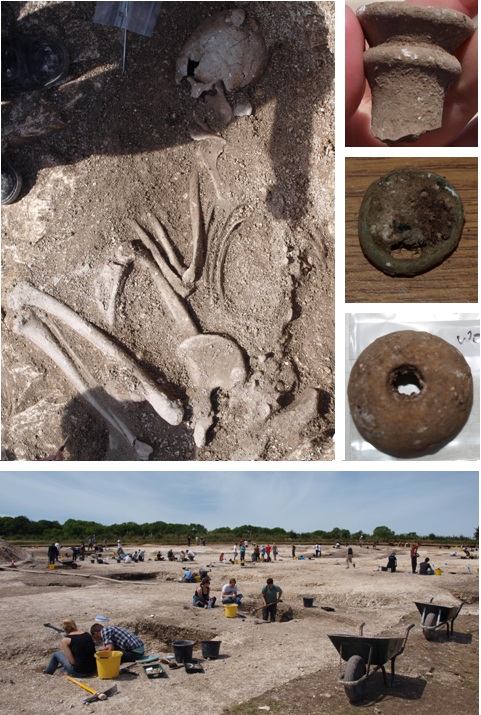Work on the site today progressed with the first years continuing excavating their features. Second years were dotted around the site supervising and assisting with uncovering artefacts within pits or ditches. The third years were clustered near the entrance of the ‘banjo’ enclosure excavating new and previously discovered features. Other third years and MSc students were allocated to trowel back the excess soil near the Roman building in doing so exposing more building debris and a wall. The site had a few familiar faces rejoining as volunteers the dig for their third or fourth time. Extra pairs of hands are always welcome to assist with excavating the site fully.
Around the site people seemed excited at the thought of possibly having a chance to appear on television tomorrow, when the BBC will be filming for the programme “Digging for Britain”. Today saw numerous people scurrying around the site ensuring that features possessing skeletal remains and other interesting artefacts were being cleaned up ready for their anticipated appearance on television.
Finds are appearing all over the site, and as emphasised before the start of the Durotriges Project, it is truly a rich in the range of material, possessing numerous unique artefacts that may alter our interpretation of how our ancestors lived. The more unusual discoveries of the day were a Roman copper alloy ring and an Iron Age fibula brooch. There was also a fragmented quern stone, a flint scraper and a circular worked piece of bone that could possible be some form of a weight. There were a few extraordinary heavy cylindrical objects of fired clay with what looks like traces of metallurgical deposits. In terms of animal remains, there have been recovered mandibles and robust skulls of sheep, horse and cow. In addition, there has been unearthed an example of a Late Iron Age/ Romano-British pot which appeared almost complete and having a pedestal base. Within the pot, there seems to be a burnt organic residue requiring further analysis in the laboratories of Bournemouth University.
Updates on the progress of the uncovered skeletal remains are as follows: a neonate found has been said by Elizabeth Craig (anthropology specialist on site) to be well preserved, which is rare due to the skeletal remains being fragile and minute. Two other skeletons have re-exposed after being discovered at the end of last year’s excavation, and so were left to be examined fully this year. One skeleton had been placed in a pit truncated by the cutting of a later building platform. The individual is provisionally identified as a male lying in a crouched burial position. The way skeletal remains have been found suggest that the deceased may have been bound to fit into the compact area or after the body had begun decomposition the limbs may have been compressed close together to fit in the grave. The second skeleton was of an individual discovered last year whilst conducting geochemical sampling at the entrance of the ‘Banjo’ enclosure.
Lauren and Zoe
